I spent the better part of last week traveling to Los Angeles. Visiting that town always makes me think about sustainability and self-sufficiency because the whole place seems so dependent on outside natural resources; although you could probably say that about most big cities. As we drove up and down Interstate-5 past all the dried up farms I couldn’t help but think about how much rainwater my nine square foot concept house could actually capture.
I came up with this slight refinement to the previous design which has a larger single roof surface that spans the interior space, porch, and bay windows. This roof is about 50 square feet and if my math is right this roof would collect about 425 gallons of water per year here in Sacramento, California. An inch of rain on a square foot of roof is good for collecting a half gallon of water. Here in Sacramento we get about 17 or 18 inches of rain each year. So correct me if I’m wrong by 17 x 50 / 2 = 425 gallons of water per year. The water tank in the illustration is 500 gallons.
You may also notice I took the house off the trailer for this illustration. I still plan to someday built this tiny house on a trailer but it seemed that for this iteration it made more sense to leave it out since a 500 gallon water tank would weigh over two tons. Yeah yikes.
The good news is that 425 gallons of water a year would keep one person alive and relatively clean. I’m pretty sure there would not be enough water left over to grow any food except for the few plants that could use the grey water from the sink and shower.
Anyway it’s nice to be back home again, drawing, dreaming, and blogging. Traveling is not one of my favorite things to do. For those of you who enjoy tinkering with Google SketchUp, here is the original file for you to explore. Enjoy!

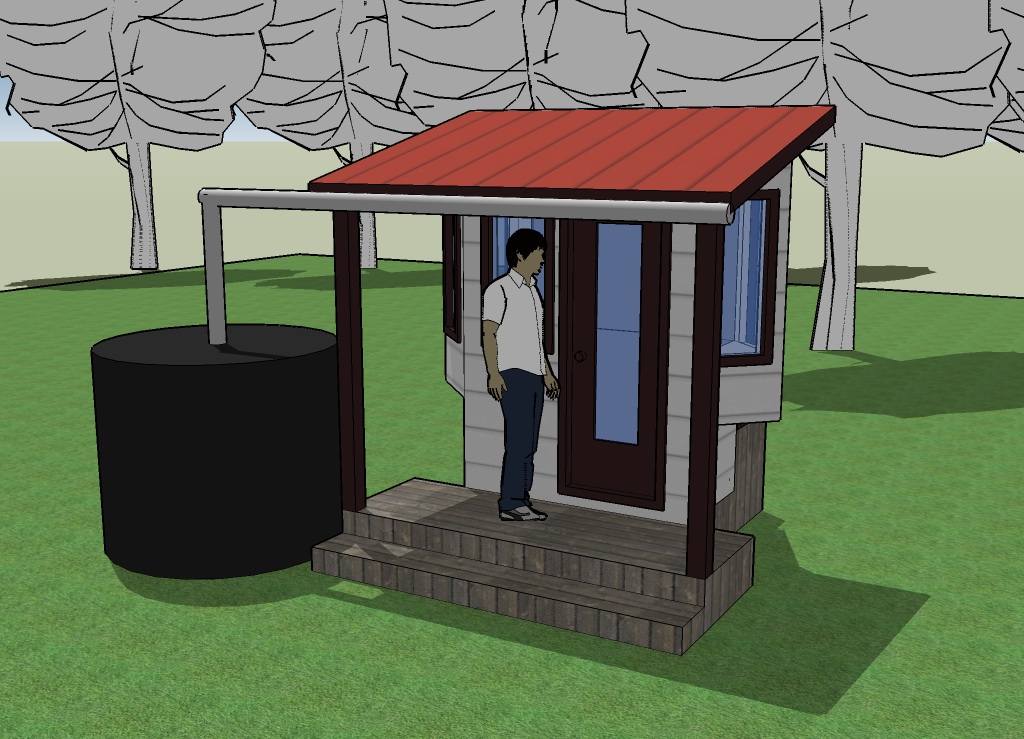
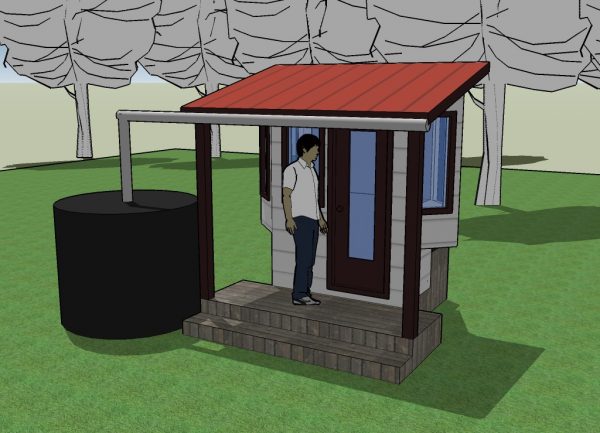
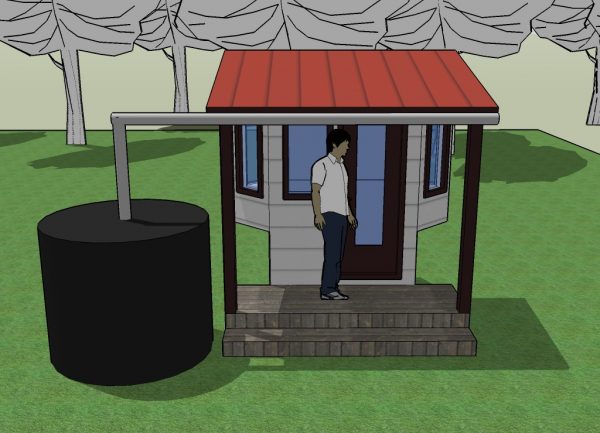
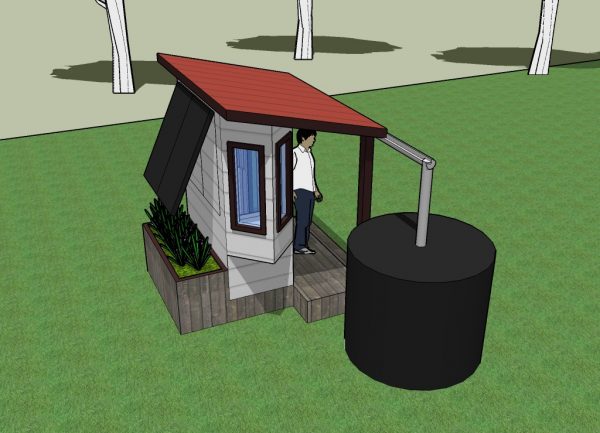
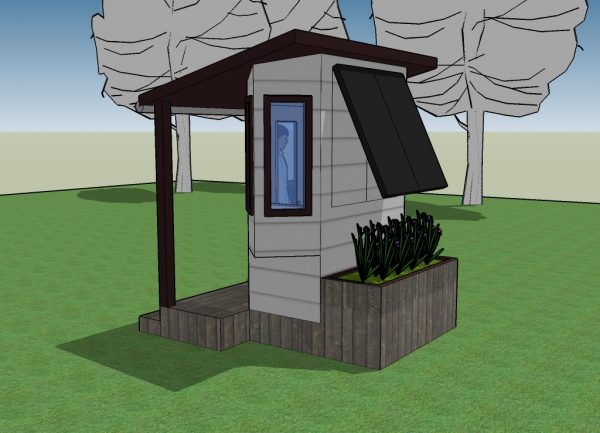
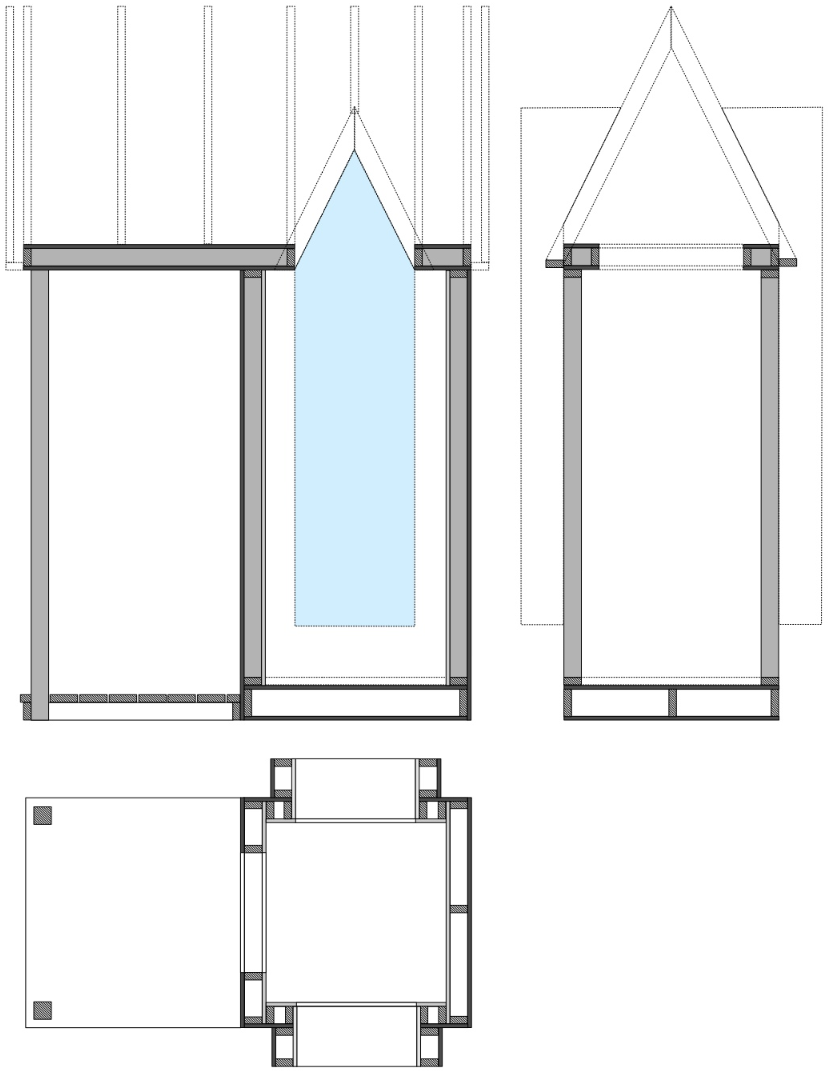
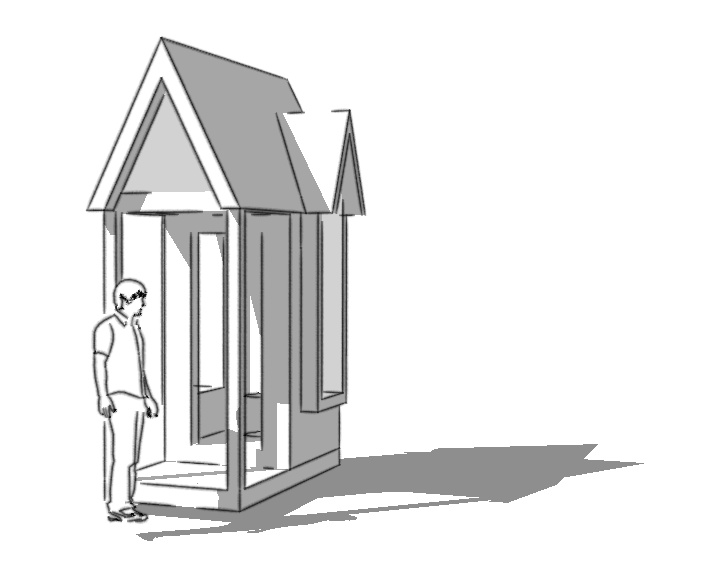
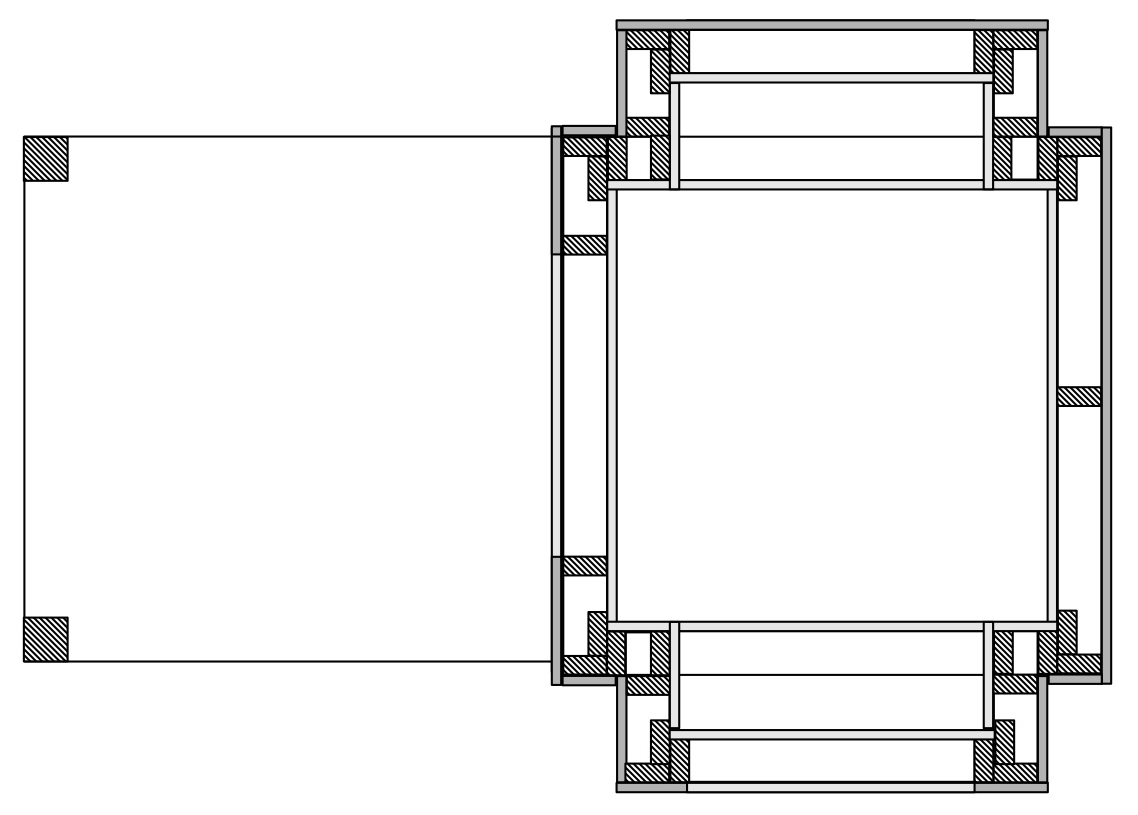
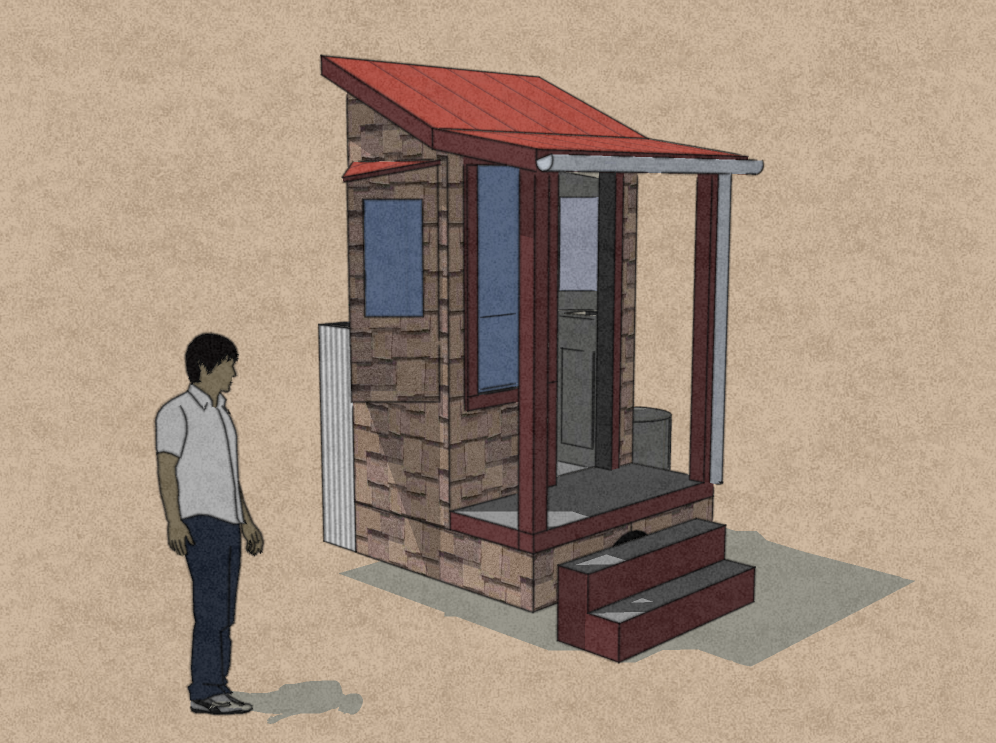
This is a beautiful job for a rain collector. Frankly, I’m amazed that this small a surface could produce enough water to be really useful–as in self-sufficiency. For the latter, one would presumably have to have a much larger collector area, depending on the location.
Hi Michael,
Certainly an interesting concept taken to the extreme. I don’t doubt your calculations but wonder if you would really need a 500 gallon collector if you only receive 425 gallons over an entire year. Assuming you don’t receive it all at one ( I could be wrong, I believe CA gets most of its rain in the winter ). If 425 is close to what 1 person needs for a year, I imagine you would be constantly running near empty so you could probably get away with a plastic rain barrel, maybe 50 gallons max. That might return it to being portable again.
Nice to see the posts again. Welcome home.
Steve
Howdy Michael,
It’s a nice change, and a single person grey water system should be more than plenty for a small planter box like the one you have there. Many people who have learned to kick the “grid” water, often learn that they can live on a gallon a day, including staying clean.
I also noticed that you moved the solar panel to the south wall, effectively completely covering it. You should think about putting it somewhere else. With such a small space, passive solar heating can go a very, very long way, but it’s that much more important to get it right.
On a side note, I’ve started playing with google sketch up. I’m working on my own tiny house drawing as well. I think, once again, my wife hates you :D.
SteveR… I bet you’re right about the water tank size. But it’s interesting to see the amount of water visually. It is interesting to note that this water ration is what is recommended for minimum survival. Depending on who you ask most American’s use between 80 to 100 gallons of water a day, not the 1+ gallon I have estimated here.
Grant… I forgot to change the solar panel placement. LOL about your wife. Maybe I can talk Julia (my wife) into starting a support group for significant-others. 🙂
What about a inexpensive means to increase the rainwater collection area? Maybe using sheet plastic, tarps, or water repellent fabric to collect the water and direct it onto the roof. The outer ends of these sheets could be elevated by something like PVC pipe so that the water would flow onto the roof. It would look like awnings extending out from the house except that the outer ends would be higher than the roof. You could probably double or triple the amount of water captured with minimal expense. Any ideas?
Good thinking Tim. The only issues that pop into my brain is wind and long-term resistance to weathering. The frame that holds the material would probably need to be fairly strong to hold up to high winds and the awning material would need to be good enough to last for a few years at least. It would make the house more portable though and provide more water to make it through dry spells.
With the solar panels what is a option if you are planing on having be portable is that there is no reason they can’t just be detached from the living area and this is also a good idea because then you don’t always have to park with the south wall pointing south as situations permit and with triple pane glass the amount of passive heating this thing would gain would be amazing. but you also want to disconnect your solar panels because depending on your latitude you want to have your panels at different angles and right now they are set up steep enough that unless you would be super far north they would collect very little energy.You also might have the right idea keeping the south wall un-windowed because with windows on all sides in the summer that thing would get incredibly hot and being able to turn one side that didn’t gain as much passive energy might be good and the less windows the better it would hold its heat in the wintertime, especially at night, making it more efficient to heat. this is also why I say use triple pane glass because with every added pane in windows the r rating doubles single pane = R-1, Double pane = R-2, triple pane = R-3+
triple pane glass is actually R-4 insulation rating. Sorry
It is just your thought I think so, since only nine tiny feet just to collect rain water is not a good idea. It must be properly planned and executed for complete home rather than nine feet only.
From:Roof
why not locate the composting toilet outside on the veranda and have a canvas screen that can be pulled around when needed, that would free up some space inside and besides, I don’t like the idea of sleeping over the toilet!!
Good point Michael… but since the whole idea is a bit extreme I’m not sure there’s much for it 🙂
The toilet (bucket) will be removable so it if got too back in there it could be set outside.
80-100 gallons/day is excessive (unless you have a dug well and septic in a rural location where you’re reusing the same water), but 1-2 gallons a day is too little.
1-2 gallons works if your electric goes out for a week in a normal house. But at the end of that week, you have a pile of dirty dishes and laundry and are in desperate need of a shower.
At minimum, you need water for drinking, doing dishes & laundry plus showering. So I think you need more like 10 gallons/day. The upside is you can use the greywater from dishes, laundry and showering for plants so that winds up included.
Hey Janzen,
I was curious, since the volume of the house is incredibly small, would you think body heat would suffice for heating? Also, 425 gallons is a bit excessive. One gallon a day would suffice for drinking water. For washing things (clothing, dishes, showering), that water can be distilled to be used over and over again. To keep the cycle of water in a relative circle, you can also distill urine since it’s 95% water anyways. As for the compost pile, kitchen waste should be put in with the tiny garden to compost in place.
I’m afraid I do not understand the purpose of such a small house. It only seems to be useful for one person. Why would one single person need their own house? I am not from the United States, and maybe I do not understand things here yet, but it seems quite unusual for one single person to have their own house on their own piece of land. Would it not be better to have a house in which several people could live together, whether they were family or no? When I first arrived in California as a single man, I had no money and no resources. I lived in a tent in a farmers field for about a year, before I saved up enough to get a car so that I could travel to look for better opportunities. Then I lived in the car. Found a nice place to settle with a job, lived in the tent in the nearby National Forest. My point is, I understand that this is to show how people could live with less, but it actually seems excessive. In my home country, you rarely, if ever, hear of somone living in their own house, alone.
The design concept is mostly for fun – to see if it could be done. I’ve not built it, yet.
Wow! This is an amazing post, lots of new things got to learn. You have done a wonderful job. Thanks a lot for sharing this, keep it up.